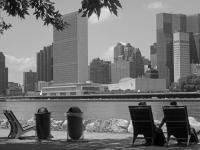Brandhorst Museum
Munich, Germany
The Brandhorst Museum houses a substantial private collection of late 20th-century and contemporary art, predominantly paintings. The building consists of a long volume that lines the street and a taller one that marks the north-eastern corner of Munich’s museum quarter. These are both clad in a textured and polychromatically treated skin, whose gradations in hue and tone give the building the appearance of three simple interlocking volumes.
The museum contains naturally lit galleries on three floors, whose rooms are distinguished by variations in sequence, dimension and proportion. A daylit patio on the lower level serves as the starting point for a suite of artificially illuminated galleries dedicated to photography, media and graphic art. The universal exhibition spaces on the ground floor are illuminated from the side by an innovative daylight guidance system, whereas the large rooms on the top floor, including the polygonal hall designed for Cy Twombly’s Lepanto Cycle, are all naturally lit from above.
The external envelope is composed of ceramic batons mounted in front of a horizontally folded metal skin. Embodying the principle of kinetic polychromy, this lends the building a dynamic appearance with countless gradations between a smooth, almost dematerialised impression when seen from afar and one of a three-dimensional woven structure from close proximity. Like a vast abstract painting, the façade communicates the spirit of the museum as a place where art comes alive.
Whereas the main objective of the museum’s interior is to create ideal exhibition conditions, that of its polychromatic exterior is to draw attention to the museum’s special character as a place of aesthetic reflection and creativity. The multilayered façade also has a technical function, however: suspended in front of the substructure and the thermal insulation is a horizontally folded bi-coloured metal sheet with fine perforations that absorb noise from traffic on the adjacent roads. Mounted vertically in front of this horizontally structured skin are 36,000 ceramic batons (4 × 4 × 110 cm) glazed in twenty-three colours, which create an oscillating outer envelope.
The overall effect of this superposition of horizontal and vertical lines, in combination with the contrast and merging of the colours, is that the solid outer walls of the building seem to vibrate and become almost immaterial, as their surface appearance changes with the movement of the observer. Countless variations of pattern and texture arise when moving between the oblique view, in which the vertical ceramic batons merge into a solid surface, and the frontal view, in which the mineral layer opens up, thereby revealing the horizontal lines of the background to full effect. Seen from afar, each colour group blends to a uniform and neutral tone with its own particular brightness and hue. As the visitor comes closer, each of these tonal fields resolves into its component colours.







